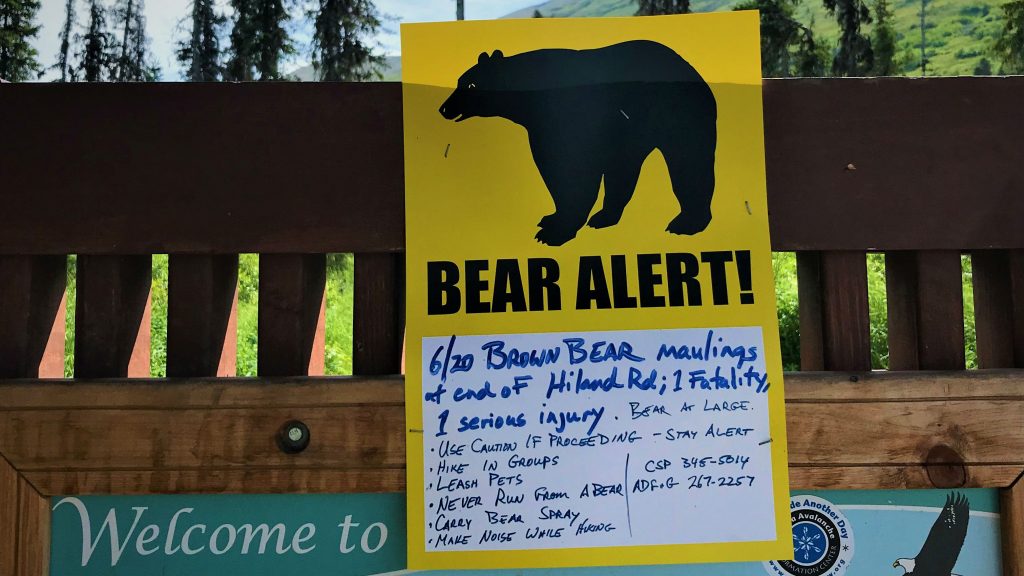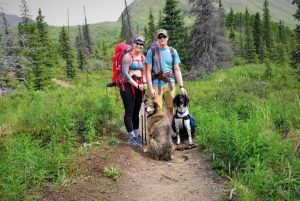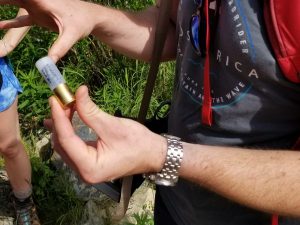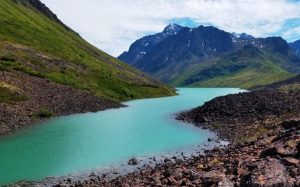After deadly bear attack, hikers in Anchorage, Alaska weigh risks

If you live in Alaska, you live in bear country. While the risk of a bear encounter or attack is low, there’s always a chance the worst could happen.
Since last summer, there have been three bear-related deaths, with the latest earlier this summer in Eagle River.
The Alaska Department of Fish and Game set traps and killed three bears, but still haven’t found the bear responsible for the June 18 attack.
That hasn’t stopped hikers from hitting the trails. On recent afternoon, Loni Quinn was out with her dad, Mike Quinn and friend, Dustin Miller.

“It’s beautiful, it’s sunny, it’s green,” Quinn said.
Quinn grew up in Eagle River and knows the trails. That’s why she didn’t second guess going out alone in late June.
“He was over there, I right here,” Quinn said, pointing just across the valley.
That’s where Michael Soltis went missing on Monday, June 18. Soltis’s body was found two days later and a member of the search party looking for him was mauled by the same bear.
More people outdoors means more bear attacks
Deadly bear attacks are considered rare in Alaska, happening once every three to four years. But just last year there were two– one outside Anchorage and the other in the Interior.
Rick Sinnott is a retired wildlife biologist. It’s possible the number of human-bear encounters are up, Sinnott said, but there are also just more humans here.
“Fifty years ago, who was jogging in the woods? Who was riding bikes in the woods? Basically nobody.” And today, Sinnott said, “we have two or three or four times more people in Anchorage — there’s way more people in the woods.”
And those people can leave scraps of food on the trails or unattended in campgrounds, which means bears get more habituated.

Going outdoors, bear or no bear
Just weeks after the last death here, these woods are packed with people.
And it’s no surprise why. The trail starts out in a forest of bright white birch and dark green spruce. It climbs along a clear, cold stream perfect for cooling off on a hot day.
Sarah Smith has a colorful sleeve of tattoos up her right arm and a can of bear spray strapped to her hips.

“It’s not a matter of if, it’s a matter of when you’re going to have a [bear] encounter,” Smith said.
Smith is camping overnight with her friend Seth Ransom and their two dogs.
“Sarah’s got the bear spray, I’ve got a .44 [pistol],” Ransom explained.
The two have talked about what they’ll do if they see a bear.
“We’re going to get together, see if we can get the dogs with us,” Ransom said. “We’ll have the [bear] spray first, firearm second. Hopefully we never have to use it.”
Ransom actually trains people for a living on how to stay safe in the backcountry. He tells his clients that having too many bear deterrents can be a bad thing.

“If you have an air horn, you have a firearm, you have a whistle, you have bear spray — in the moment you’re not going to know which one to go for,” Ransom said.
On the trail this day, some people had bells on their dogs’ collars, others had guns strapped to their chest or slung over their shoulders.
The Alaska Department of Fish and Game’s guide to staying safe in bear country focuses on bear spray and firearms as the top deterrents.
Hikers undeterred
Despite the hype of bear stories on social media and the recent death in this valley, hikers here said mostly they’re not afraid.
“I really just think you have to keep perspective,” Loni Quinn said. “Otherwise, I would just have fear and paranoia.”

Over the hundreds of hikes she’s gone on, Quinn said she’s only seen five or six bears.
“That’s the way I rationalize it,” Quinn explained, “Because I love being outside and I love hiking and I don’t want to give up what I love so much just because I’m afraid of running into something that probably doesn’t want anything to do with me anyway.”
There’s a cow and two moose calves up along the ridge, but no sign of bears on this day– an added relief on top of the hike’s grand finale.
Across a foot bridge and beyond a big field of boulders Eagle and Symphony Lakes open up. They glow a bright, tropical blue in the long, summer sunshine.
Related stories from around the North:
Canada: Man in Northern Canada killed protecting his children from polar bear, CBC News
Finland: Rural Finland won’t be fully compensated for predator damage, Yle News
Norway: Polar bear shot dead after attacking person on Svalbard, The Independent Barents Observer
Russia: Russia plans fenced parks to confine reindeer herding in Arctic, The Independent Barents Observer
Sweden: Helping people face “unbearable” fear, Radio Sweden
United States: Opponents skeptical as U.S. Gov claims seismic survey will have “insignificant” impact in ANWR, Alaska Public Media



